#172: Enola Gay by Orchestral Manoeuvres In The Dark
City: Ottawa, ON
Radio Station: CFRA
Peak Month: May 1981
Peak Position in Ottawa ~ #9
Peak position in Vancouver ~ did not chart
Peak Position on Billboard Hot 100 ~ did not chart
Peak Position on Italian Singles chart ~ #1
Peak Position on Portuguese Singles chart ~ #1
Peak Position on Spanish Singles chart ~ #1
Peak Position on Swiss Singles chart ~ #2
Peak Position on French Singles chart ~ #6
YouTube: “Enola Gay”
Lyrics: “Enola Gay”
Orchestral Manoeuvres in the Dark (OMD) is a band that formed in 1978 in the Liverpool suburb of Wirral, UK. The bands’ co-founder, George Andrew “Andy” McCluskey, was born in 1959 in the town of Heswall on The Wirral peninsula. In primary school McCluskey met Paul Humphreys. The two teamed up in their teens to play in the bands Hitlerz Underpantz, VCL XI and the Id. The latter was a synth-pop band that also included future OMD member Malcolm Holmes. Paul David Humphreys was born in 1960 Merseyside. He was influenced by Kraftwerk and Brian Eno. Malcolm Holmes was born in a suburb of Merseyside in The Wirral in 1960. When the Id was founded in 1977, Holmes became the band’s drummer. He joined OMD in 1980. Martin Cooper was born in 1958 and joined OMD in 1980.
Andy McCluskey was the lead vocalist for the band, also playing lead guitar, bass guitar and keyboards. Paul Humphreys played piano and keyboard, as well as backing vocals – though he occasionally was the lead vocalist. Malcolm Holmes played drums and percussion, while Martin Cooper contributed saxophone, keyboards and backing vocals.
In 1980 the band released their self-titled debut album Orchestral Manoeuvres in the Dark. They released four singles from the album, with the fourth – “Messages” – charting highest on the UK singles chart at #13.
In 1980 Orchestral Manoeuvres In The Dark released an anti-war song titled “Enola Gay”.
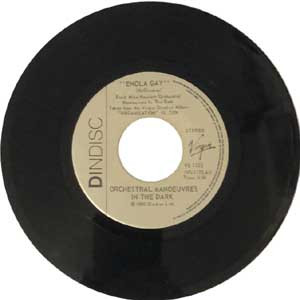
The song was cowritten by OMD bandmates McCluskey and Humphreys, and was a track on their second studio album Organisation. “Enola Gay” is the name of the Boeing B-29 Superfortress bomber that dropped the atomic bomb on Hiroshima on August 6, 1945. The bomber was named after Enola Gay Tibbets, the mother of the pilot of the Enola Gay, Colonel Paul Tibbets. The Enola Gay became the first aircraft to drop an atomic bomb in warfare. The bomb, code-named “Little Boy”, was targeted at the city of Hiroshima, Japan, and destroyed about three-quarters of the city. Enola Gay participated in the second nuclear attack as the weather reconnaissance aircraft for the primary target of Kokura (pop. 130,000). Clouds and drifting smoke over Kokura resulted in Nagasaki, a secondary target, being bombed instead on August 9, 1945. The Enola Gay was not the aircraft that dropped a bomb on Nagasaki, but responsible for signaling this new target after Col. Tibbets determined the weather was not good for dropping a bomb on Kokura.
On August 6, 1945, at 8:15 AM “Little Boy” was dropped over Hiroshima.
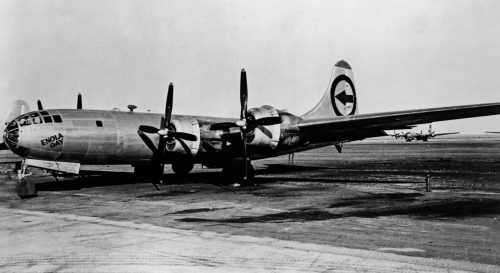
The Enola Gay stayed over the target area for two minutes and was 10 miles away when the bomb detonated. Due to crosswind, the bomb missed the aiming point, the Aioi Bridge, by approximately 800 feet and detonated directly over Shima Surgical Clinic. Only Tibbets and two other crew on board knew of the nature of the weapon; the others on the bomber were only told to expect a blinding flash and given protective goggles. “It was hard to believe what we saw”, Tibbets told reporters, while Parsons said “the whole thing was tremendous and awe-inspiring … the men aboard with me gasped ‘My God’.”
Over 90 percent of the doctors and 93 percent of the nurses in Hiroshima were killed or injured—most had been in the downtown area which received the greatest damage. The hospitals were destroyed or heavily damaged. Only one doctor, Terufumi Sasaki, remained on duty at the Red Cross Hospital.
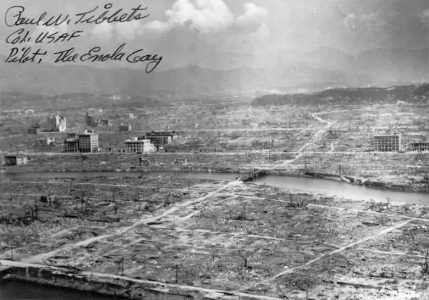
Photo taken from Enola Gay of Hiroshima after the bombing
At the time of the bombing, including Japanese soldier in training in the city, the population of Hiroshima was estimated to be about 350,000. According to a Newsweek report in 2020, over 140,000 were killed during the bombing. In the years that followed, another 62,000 died of radiation poisoning, bringing the total death toll from the August 6th, 1945, detonation to over 200,000.
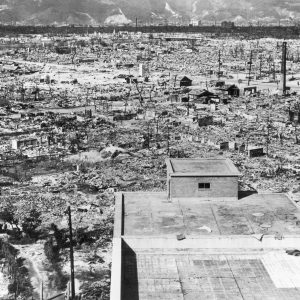
About 20 minutes later the Tokyo railroad telegraph center realized that the main line telegraph had stopped working just north of Hiroshima. From some small railway stops within 16 km (10 mi) of the city came unofficial and confused reports of a terrible explosion in Hiroshima. All these reports were transmitted to the headquarters of the Imperial Japanese Army General Staff.
Military bases repeatedly tried to call the Army Control Station in Hiroshima. The complete silence from that city puzzled the General Staff; they knew that no large enemy raid had occurred and that no sizable store of explosives was in Hiroshima at that time. A young officer was instructed to fly immediately to Hiroshima, to land, survey the damage, and return to Tokyo with reliable information for the staff. It was felt that nothing serious had taken place and that the explosion was just a rumor.
The staff officer went to the airport and took off for the southwest. After flying for about three hours, while still nearly 160 km (100 mi) from Hiroshima, he and his pilot saw a great cloud of smoke from the firestorm created by the bomb. After circling the city to survey the damage they landed south of the city, where the staff officer, after reporting to Tokyo, began to organize relief measures.
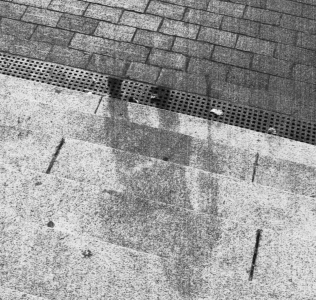
The shape of a victim burned into the steps of a bank.
Sixteen hours after the bomb was dropped, President Harry Truman announced on radio “The world will note that the first atomic bomb was dropped on Hiroshima, a military base…. We have used it to shorten the agony of war. In order to save the lives of thousands and thousands of young Americans. We shall continue to use it, until we completely destroy Japan’s power to make war.”
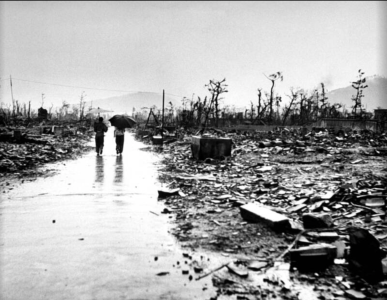
“Enola Gay” peaked at #9 in Ottawa. It also charted on Top 40 radio in Sherbrooke (PQ) and Bethesda (MD). Internationally, “Enola Gay” peaked at number-one in Italy, Portugal and Spain, #2 in Switzerland, #6 in France, #8 in the UK, and #14 in Ireland.
Their next single release was “Joan Of Arc“, from their album Architecture & Morality. It was inspired by the historical figure who lived from 1412 to 1431 and was burned at the stake at the age of 19. In the spring of 1982 “Joan Of Arc” peaked at #5 in Toronto, #7 in Winnipeg (MB), and #15 in Vancouver (BC) and Halifax (NS). Internationally, the single peaked at #5 on the UK singles chart.
OMD’s “Souvenir” was next up and climbed to number-one in Portugal and Spain, #3 in the UK, and #9 in Ireland. Both “Joan of Arc” and “Souvenir” were singles from OMD’s album Architecture & Morality.
Back in the UK, OMD released a followup Joan of Arc-themed single titled “Maid Or Orleans (The Waltz of Joan of Arc)”. The single became a number-one hit in Germany, Belgium, the Netherlands and Spain. Elsewhere it climbed to #2 in Austria, #4 in Switzerland and the UK, #5 in Ireland, and #7 in New Zealand.
In 1983 the debut single from OMD’s album Dazzle Ships titled “Genetic Engineering” peaked in the Top Ten Alternative Radio charts in both Edmonton (AB) and Montreal. In 1984 OMD released Junk Culture. The debut single titled “Locomotion” was a song with different lyrics than the Little Eva hit from 1962. “Locomotion” climbed to #4 in Ireland, and #5 in the Netherlands and the UK in 1984. It also climbed into the Top 30 in Montreal on AM-Top 40 radio. A second single from Junk Culture titled “Talking Loud And Clear” peaked at #11 in the UK. But it failed to get much airplay in North America.
The band next released an album titled Crush with the lead single “So In Love”. In Vancouver (BC) the single climbed to #8 in late November 1985. The single made the Top Ten on the Alternative Radio charts in Edmonton (AB) and Calgary (AB). It was the first single to chart on the Billboard Hot 100, climbing to #26. This was aided by its number-one peak in San Francisco, The followup single was “Secret”.
In 1986 OMD’s song “If You Leave” was featured in the teen romance Pretty In Pink. The exposure gave the band their first Top Ten hit in the USA, peaking at #4 on the Billboard Hot 100 and #2 in Vancouver (BC). Also that year, OMD released the studio album Pacific Age. The lead single “(Forever) Live And Die” climbed to #1 in Vancouver (BC) and #19 on the Billboard Hot 100.
In 1988 OMD released a new single titled “Dreaming” on The Best of OMD. On May 4, 1988, OMD appeared in concert again at the Pacific Coliseum in Vancouver as the opening act for Depeche Mode.
McCluskey split from the band in 1989, taking with him rights to OMD. This left Humphreys, Holmes and Cooper to find a new record label and form a new group they named The Listening Pool. In 1991 Andy McCluskey, with a new musicians released OMD’s eighth studio album, Sugar Tax. The lead single, “Sailing On The Seven Seas”, peaked at #3 in Austria, the UK and Sweden, #5 in Ireland and #9 in Germany. The followup single from the album, “Pandora’s Box”, peaked at #7 in Austria, Sweden and the UK late in 1991.
In the 1980s and 90s OMD managed to chart four singles into the Top Ten on the Billboard Dance Club Songs chart. The last of these singles was “Stand Above Me” which climbed to #6 on the chart in 1993. It was the lead single from Liberator their ninth studio album. Their last Top 20 hit in the UK was in 1996 with “Walking On The Milky Way”. Disillusioned with the prevalence of BritPop in the mid-90s, Andy McCluskey disbanded OMD in 1996.
In 1996 Paul Humphreys began to collaborate with Claudia Brücken, the former lead singer of the German synth-pop band Propaganda. They wrote songs and performed in concert until 2013. In 1998 Andy McCuskey founded a girl group called Atomic Kitten, co-writing their number-one 2001 UK hit single “Whole Again”. In addition he co-wrote four of their other Top Ten hits that appeared on the UK singles chart between 1999 and 2005.
In 2006 McCluskey, Humphreys and Holmes reunited. In 2007 Martin Cooper rejoined OMD. The band has continued to tour and in 2011 released the album History of Modern. The past decade the band has appeared in concert in Vancouver at the Commodore Ballroom on September 30, 2011, and on April 5, 2013.
OMD has continued to record over the decades with their 13th studio album, The Punishment Of Luxury, released in 2017. Touring with their album, the band performed at the Commodore Ballroom in Vancouver (BC) on March 23, 2018. Since 2015 Stuart Kershaw has been the OMD’s drummer.
Posted on the 80th anniversary of the bombing of Hiroshima, on August 6, 1945.
August 6, 2025
Ray McGinnis
References:
“Darryl Smyers, “Q&A: OMD’s Paul Humphreys Talks Reformation, The Return of Intelligent Music and Being in Hitler’s Underpants,” Dallas Observer, March 18, 2011.
Julian Marszalek, “OMG It’s OMD! Orchestral Manoeuvres In The Dark Interviewed,” The Quietus, October 7, 2011.
Greg Kot, “OMD: Dystopian Electro-pop and the Chicago Connection,” Chicago Tribune, March 15, 2018.
“Interview with Andy McCluskey of Orchestral Manoeuvres in the Dark (OMD).” Kickin’ it Old School blog, March 10, 2011.
“Kokura, Nagasaki and the luck of the last 75 years,” New York Daily News, August 9, 2020.
President Harry Truman, “President Truman on Hiroshima,” White House, Columbia Broadcasting System, August 9, 1945.
“How Many People Died in Hiroshima and Nagasaki?,” Newsweek, August 3, 2020.
Gar Alperovitz, Atomic Diplomacy – Hiroshima and Potsdam: The Use of the Atomic Bomb and the American Confrontation with Soviet Power, (InternetArchiveBooks, 1965).

CFRA 580-AM Ottawa Top Ten | May 29, 1981

Leave a Reply